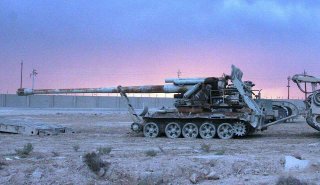Russia’s Long-Range Artillery Nightmare: Meet the North Korean M-1989 Koksan
The gun features a gigantic 8-meter barrel, which holds a record as one of the longest barrels of any self-propelled artillery system in the world.
North Korea’s threat to their neighbors to the south, indeed much of the rest of the region, is often closely associated with their nuclear weapons program. If we’re lucky, some analyst will remind us that North Korea’s biological and chemical weapons program is far older, more complex, and expansive than the North Korean nuclear weapons arsenal.
But perhaps an even more significant—indeed, persistent and growing—threat to South Korea comes from North Korea’s immense artillery.
Specifically, North Korea's Koksan M-1989 170mm Self-Propelled Howitzer cannon is a serious threat to the safety of South Korea. With the world’s largest artillery network arrayed just across the border from South Korea, Western analysts had better start sounding the alarm about North Korea’s artillery far more than even Pyongyang’s nuclear weapons program.
Understanding the Koksan
The M-1989 Koksan is an evolution of an earlier North Korean artillery model, the M-1978. The Koksan features a 170mm gun-mounted on a tracked chassis, enhancing both the maneuverability and operability of the weapon system across the hilly and overall rough Korean terrain. The gun itself features a gigantic 8-meter barrel, which holds a record as one of the longest barrels of any self-propelled artillery system in the world.
Standard ammunition shells for the Koksan can reach as far as 25 miles away. North Korea’s Koksan, however, can fire rockets as well as conventional artillery shells. These rockets can reach 37 miles away.
One of the key drawbacks to this system is its relative slow rate of fire. It can only launch one to two rounds every five minutes due to the large size and complexity of the ammunition involved. Of course, this weakness is surmounted by the fact that North Korea has a layered network of heavy artillery systems deployed to make up for the slow rate of fire of systems like the Koksan. Further, the M-1989 carries 12 rounds of ammunition onboard.
Like so much North Korean weapons technology, the M-1989 Koksan is based on old Soviet technology from the Cold War. Notably, the Soviet-made ATS-59 artillery tractor forms the basis of the Koksan. Although, the Koksan modified the old Soviet system to better handle the weight and recoil of the Koksan’s massive 170mm gun.
Some have even speculated that the Koksan was inspired by much older Soviet systems from the 1950s, with others going as far to say that Pyongyang may have adapted the system from old German Wehrmacht artillery, as North Korea did with when they copied the old Wehrmacht 17cm Kanone 18.
Another downside to the M-1989 is its open configuration, which makes the system vulnerable to direct attacks. Most artillery systems in use in the world have some level of protection for the system itself and the crew manning it. But that is not the case for North Korea’s M-1989.
What would one expect from a regime, such as North Korea, that holds one of the world’s lowest rankings in terms of human rights?
The M-1989 Koksan Combat History
The Koksan has seen combat in different hotspots around the world, notably by the Islamic Republic of Iran in its bloody war with Iraq in the 1980s. North Korea’s Koksan provided long-range bombardment for the Iranians, who were fighting to stop Saddam Hussein’s Iraqi Army from conquering Iran.
Iran used this system for counter-battery fire at extremely long ranges, placing it well beyond the reach of enemy artillery, giving the Iranian military an advantage over the otherwise more advanced Iraqi Army.
Interestingly, as part of their close association, the Koksan has been deployed to Russia for use in their war against neighboring Ukraine. The unique 170mm caliber of the Koksan presents logistical challenges for Russia, since the weapon does not align with standard Russian artillery calibers, meaning that North Korea must supply large quantities of specialized ammunition for the Koksans in Russia.
Then again, that works to the favor of the North Koreans, who make gobs of money off selling the M-1989 Koksan and its special ammunition to Russia as well as get to perfect their defense industrial base.
The M-1989 Koksan and its unique capabilities prove that the North Korean artillery threat to the South is real. At a moment’s notice, these systems could be activated and used to decimate major South Korean cities. The loss of life would be catastrophic.

